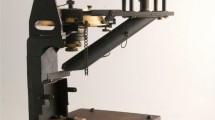Abstract
In connection with the 100th anniversary of the discovery of the phenomenon of the diffraction of X-rays by crystals (Max von Laue, 1912) and the basics of X-ray crystallographic analysis (Lawrence Bragg, 1913), the article marks the major milestones in this outstanding event in the history of science. Special emphasis is given to the role of Russian scientists (E. S. Fedorov, G. V. Vulf) in the emergence and early steps in the establishment of this discovery being one of the pillars of the scientific revolution of the first half of the past century.
Similar content being viewed by others
References
W. W. Schmahl and W. Steurer, Acta Crystallogr., A68,No 1, 1/2 (2012).
M. Eckert, Z. Kristallogr., 227, 27–35 (2012).
M. Laue, Geschichte der Physik, Bonn (1950).
M. Laue, Interferenzerscheinungen bei Röntgenstralen, Leipzig (1913).
P. Ewald, Phys. Z, 14, 465–472 (1913).
M. J. Burger, Vector space and its application in crystal-structure investigations, John Wiley, N.Y. (1959).
I. I. Shafranovskii, History of the Science of Crystals. 1. From Ancient Times to the Beginning of the 19th Century [in Russian], Nauka, Leningrad (1978). 2. The 19th Century [in Russian], Nauka, Leningrad (1980). 3. Crystallography in the USSR (1917–1991) [in Russian], Nauka, Saint-Petersburg (1996).
Fedorov Evgraf Stepanovich. Scientific heritage. Correspondence. Unpublished and little-known works [in Russian], Nauka, Leningrad (1991).
H. Kubbinga, Acta Crystallogr., A68, No. 1, 3–29 (2012).
G. V. Vulf, Priroda, January, 27 (1913).
G. V. Wulff, Phys. Zs, Bd. 14, 217 (1913).
G. V. Vulf, Priroda, June, 667 (1913).
G. V. Wulff, Zs. Krystallogr., Bd. 52, S. 65 (1913).
G. V. Vulf, Fizika, No. 1, 10 (1913).
E. S. Fedorov, Zap. Gorn. Inst., 5, Iss. 1, 68 (1914).
E. Fedorow, Z. Krist. Miner., Bd. 54, H. 2, 163 (1914).
V. S. Urusov and T. N. Nadezhina, J. Struc. Chem., 50,Suppl., S22–S37 (2009).
P. M. Zorky, Symmetry of Molecules and Crystal Structures [in Russian], MSU, Moscow (1986).
E. S. Fedorov, Priroda, March, 76–81 (1915).
Author information
Authors and Affiliations
Corresponding author
Additional information
Original Russian Text © 2014 V. S. Urusov.
__________
Translated from Zhurnal Strukturnoi Khimii, Vol. 55, Supplement 1, pp. S14–S20, 2014.
Rights and permissions
About this article
Cite this article
Urusov, V.S. Role of Russian scientists in the discovery of X-ray crystallographic analysis in the beginning of the scientific revolution of the 20th century. J Struct Chem 55, 1200–1205 (2014). https://doi.org/10.1134/S0022476614070026
Received:
Published:
Issue Date:
DOI: https://doi.org/10.1134/S0022476614070026



